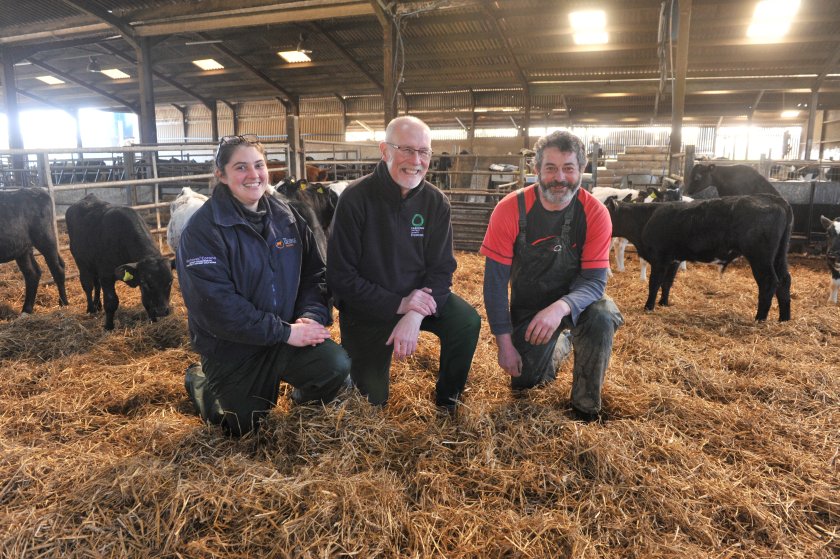
Making key changes to calf housing and feeding protocols is helping a Pembrokeshire dairy farm improve youngstock health.
When Parc y Morfa Farms Ltd made the switch from beef farming to milk production in 2015, the housing didn’t allow for a separate area for calves.
They are reared in the same building as older animals and, by sharing that air space, there were consequences for disease transmission for the younger more vulnerable animals.
Calf pens were also set up for large groups and the ‘all in all out’ system that had been in place when beef calves were bought in for rearing on an automatic calf feeder.
When this approach was applied to the farm’s block calving pattern, with big groups of different ages, younger animals with less established immune systems came under pressure from disease.
The problem intensified as cow numbers increased, to the current 220-head herd.
To find solutions going forward, the Williams family joined forces with the Welsh government's Farming Connect scheme in a ‘calf decision tree’ focus farm project with expert advice provided by vet Kat Hart, of the George Veterinary Group.
A number of changes were introduced: Housing has been retrofitted with Yorkshire boarding to improve ventilation.
Calves are fed fresh whole milk at a protein and fat level of 28-32% - substantially higher than the calf milk replacer (CMR).
And calves are reared in smaller groups, 10-15 all within a two-week age range.
Calf health has improved but the Williams’ have decided to take the programme of improvements a step further by investing in a dedicated calf shed, due to be commissioned this spring.
The 105 feet by 50 feet steel-frame building with capacity for housing 140 calves is positioned on a south-westerly site for good circulation of clean air.
It stands 11 foot to the eaves with a raised ridge vent and has a higher than usual number of Perspex roof sheets to maximise the amount of sunlight coming in.
Calves will be grouped in pens of 10, each with a dedicated straw-bedded lying area away from the feeders and drinkers to minimise moisture on the bedding.
The shed has been designed to make it easy to use, says Rhys Williams, who farms with his brother, Randal, and father, Phil, and is in charge of calf rearing at Trebover. “If a job is easier to do it is more likely to be done," he suggests.
“For instance, our current system has lots of gates tied together and this makes calf management difficult."
During a recent Farming Connect open day at Trebover Farm, Dr Hart gave a step-by-step guide on the key requirements farmers should expect from calf housing.
She emphasised why getting this right is so important: “Calves are the future of a herd, if we can invest in them in those crucial first six weeks the heavier and healthier they will be at weaning.
"That will translate to milk production and longevity when they join the milking herd or into feed conversion efficiency in finishing cattle."
Fresh air circulating in a building through good ventilation will kill many viruses, Dr Hart advised. “If we can get fresh air in, the fewer the bugs and nitrates in the calves’ environment."
Because of their size, calves are not heavy enough to trigger the so-called ‘stack effect’, when body heat forces stale air up and out through the eaves.
Therefore where calf buildings are positioned is important; a fan system or positive pressure tube may be needed.
Draughts only need to be travelling at 0.3m a second for the calf to feel a chill so if making changes to existing sheds consider using bales or sheeting to create barriers from draughts at calf height, suggested Dr Hart.
As well as draughts, moisture levels must be kept to a minimum too – it takes 3.4 hours of calf energy to evaporate one litre of water, energy that the animal could be instead using to convert their feed into growth.
Moisture also increases the speed of spread of pathogens like cryptosporidium.
Dr Hart added: “If there are five days when the temperature doesn’t get above 10°C, start putting on coats or adding in additional milk or milk powder."
Calf sheds should be designed for ease of cleaning with specific disinfectants – in all-year-round calving herds there should be a deep clean once a year when sheds are cleaned and left empty to dry for two weeks.
Consider having foot dips at the shed entry and exit points to limit disease spread, advised Dr Hart.
